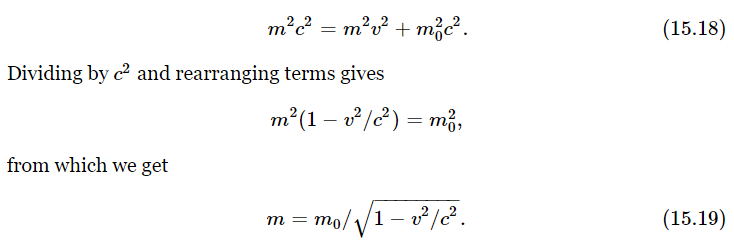
Equivalence of mass and energy
 المؤلف:
Richard Feynman, Robert Leighton and Matthew Sands
المؤلف:
Richard Feynman, Robert Leighton and Matthew Sands
 المصدر:
The Feynman Lectures on Physics
المصدر:
The Feynman Lectures on Physics
 الجزء والصفحة:
Volume I, Chapter 15
الجزء والصفحة:
Volume I, Chapter 15
 2024-02-25
2024-02-25
 1981
1981
The above observation led Einstein to the suggestion that the mass of a body can be expressed more simply than by the formula (15.1), if we say that the mass is equal to the total energy content divided by c2. If Eq. (15.11) is multiplied by c2 the result is

Here, the term on the left expresses the total energy of a body, and we recognize the last term as the ordinary kinetic energy. Einstein interpreted the large constant term, m0c2, to be part of the total energy of the body, an intrinsic energy known as the “rest energy.”
Let us follow out the consequences of assuming, with Einstein, that the energy of a body always equals mc2. As an interesting result, we shall find the formula (15.1) for the variation of mass with speed, which we have merely assumed up to now. We start with the body at rest, when its energy is m0c2. Then we apply a force to the body, which starts it moving and gives it kinetic energy; therefore, since the energy has increased, the mass has increased—this is implicit in the original assumption. So long as the force continues, the energy and the mass both continue to increase. The rate of change of energy with time equals the force times the velocity, or

We also have (Chapter 9, Eq. 9.1) that F=d(mv)/dt. When these relations are put together with the definition of E, Eq. (15.13) becomes

We wish to solve this equation for m. To do this we first use the mathematical trick of multiplying both sides by 2m, which changes the equation to

We need to get rid of the derivatives, which can be accomplished by integrating both sides. The quantity (2m) dm/dt can be recognized as the time derivative of m2, and (2mv) ⋅d(mv)/dt is the time derivative of (mv)2. So, Eq. (15.15) is the same as

If the derivatives of two quantities are equal, the quantities themselves differ at most by a constant, say C. This permits us to write

We need to define the constant C more explicitly. Since Eq. (15.17) must be true for all velocities, we can choose a special case where v=0, and say that in this case the mass is m0. Substituting these values into Eq. (15.17) gives

We can now use this value of C in Eq. (15.17), which becomes

This is the formula (15.1), and is exactly what is necessary for the agreement between mass and energy in Eq. (15.12).
Ordinarily these energy changes represent extremely slight changes in mass, because most of the time we cannot generate much energy from a given amount of material; but in an atomic bomb of explosive energy equivalent to 20 kilotons of TNT, for example, it can be shown that the dirt after the explosion is lighter by 1 gram than the initial mass of the reacting material, because of the energy that was released, i.e., the released energy had a mass of 1 gram, according to the relationship ΔE=Δ(mc2). This theory of equivalence of mass and energy has been beautifully verified by experiments in which matter is annihilated—converted totally to energy: An electron and a positron come together at rest, each with a rest mass m0. When they come together, they disintegrate and two gamma rays emerge, each with the measured energy of m0c2. This experiment furnishes a direct determination of the energy associated with the existence of the rest mass of a particle.
_________________________________________________________________
Margin
1- The electrons would actually win the race versus visible light because of the index of refraction of air. A gamma ray would make out better.
 الاكثر قراءة في النظرية النسبية الخاصة
الاكثر قراءة في النظرية النسبية الخاصة
 اخر الاخبار
اخر الاخبار
اخبار العتبة العباسية المقدسة


